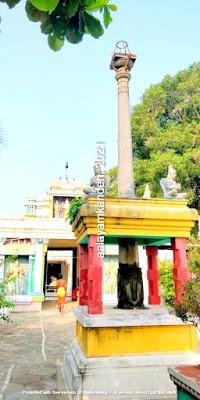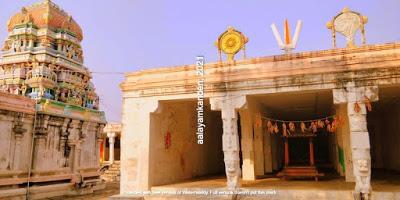
Uttara Veeraraghava Perumal Temple, Dharapuram
This is the second in the series of articles on the ten Hanumans installed by Saint Vyasaraja Theertha, (the Rajaguru of the Vijayanagara Empire during the time of King Krishnadevaraya, believed to be the reincarnation of Prahalada and the previous avatara of Guru Sri Raghavendraswamy) in and around Dharapuram in Tiruppur District of Tamil Nadu.
Saint Vyasaraja installed 732 such Hanumans during his travels across India. He would draw the image of Hanuman on a piece of stone using his Angarakatti which would then become a sculpture. Angaram is used by Madhwas to mark their forehead before eating food. It is prepared by burning dry banana peel and adding turmeric and ash from the pooja into it. This is then kept on the forehead prior to consuming prasada.
Out of the ten Hanumans, the first, Kadu Hanumantharaya Swamy was covered in an earlier article which can be found here.
The ten Hanumans in Dharapuram are spread in clusters. One key suggestion while visiting them is to make sure you cover the ones that are open for shorter durations first, before visiting the larger temples that stay open for longer.
From the Kadu Hanumantharaya Swamy temple, we proceeded to the Uttara Veeraraghava Perumal temple in the fort area. There are two Vyasaraja Hanumans here - Veera Anjaneyar and Kottaivasal Anjaneyar.

On the way to the Veera Anjaneya Swamy Shrine
In India, there are multiple locations that associate themselves with legends such as Ramayana and Mahabharatha. In the Mahabharatha, the Pandava princes were required to stay incognito for a year and they chose to do so in the Virata Kingdom. Places that are referred to as Viratapuri or Viratapuram are found in Rajasthan, Jammu & Kashmir, Andhra Pradesh and Tamil Nadu.

Lion pillared mandapa at the Uttara Veeraraghava Swamy Temple, Dharapuram
Dharapuram in the ancient times was also known as Viratapuram. It is commonly believed that this was the place where the Pandavas stayed incognito for a year under the protection of the Virata King whose children Uttara Kumara and Uttara were named after the Uttara Veeraraghava Perumal. The Uttara Veeraraghava Perumal temple is found within the Dharapuram fort and it was here that the Kings who ruled over this region coronated themselves. The Lord is also known as Uttaravu Raghava Perumal, for it is with his permission that the Kings would ascend the throne. Moreover, Dharapuram is found on a straight line to Mantralayam, where the Brindavana of Guru Sri Raghavendraswamy is found, making it even more significant.
Inscription mentioning Rajarajapuram in the Uttara Veeraraghava Perumal Temple
There are several inscriptions in this temple, that speak about Dharapuram and the kings who ruled over it. Dharapuram was earlier called Naraiyanur Nattu Brahmadeyam Rajadhiraja Chaturvedimangalam, Naraiyanur Nattu Rajarajapuram and Kongu Vanchiyaana Viladapuram. The Lord was called Uttaraghava Perumal and inscriptions also speak about Goddess Perumkarunai Selvi. These inscriptions have been documented by the ASI in the Annual reports on Indian Epigraphy - 1910, 1920 and 1961-62 as well as Tiruppur Mavatta Kalvettugal published by the TN State Archaeology department. They speak about the grants provided by the Kongu Cholas and Vijayanagara rulers as well as generals to the Uttara Veeraraghava Perumal Temple.
The Lord Veeraraghava Perumal is seen alone in the sanctum without his consorts. Instead of holding the Conch and Discus in his hands,they are found on his chest which is a unique feature about this deity.
Sri Uttara Veeraraghava Perumal, Dharapuram
Several wars that happened around this place have damaged the temple and one can see stones with inscriptions from a Siva temple been used while rebuilding the temple. Chadran, who works in the Revenue Department, shares that for best part of his childhood, the temple remained dilapidated and uncared for. He recalls a secret passage close to the sanctum sanctorum which used to be dark and as children they would attempt to explore if it lead out of the fort area. This secret passage has been documented by the archeology experts as well and subsequently closed.
2. Veera Anjaneya Swamy

Veera Anjaneya Swamy, Dharapuram
The Veera Anjaneya Swamy installed by Vyasaraja is found in a seperate shrine outside the main temple complex. The Lord is found with a child-like face, facing the South. Instead of a bloomed Sowgandhika flower as normally depicted in Vyasaraja Hanumans, he is seen holding an entire bunch of them. The tail above has a single bell tied to it and the Vaishnavaite symbols - Conch, Discus and Naamam are also found on the idol.The Veera Anjaneya Swamy was found in the open until 2004 when a shrine was constructed for him.
3. Kottai Vaasal Anjaneyar
The third among the ten Anjaneyars is found about 100 metres from the Uttara Veeraraghava Perumal Temple right next to a sixteen pillar Vasantha Mandapa from the Vijayanagara Period. It is indeed painful to see this beautiful mandapa being eaten away by vegetation due to lack of upkeep and maintenance.

The dilapidated Vasantha Mandapa from the Vijayanagara Period
The Kottai Vaasal Anjaneyar is perhaps the most beautiful among the ones I had witnessed in Dharapuram. With a baby face, he faces the North while his feet are pointed in the direction of the Uttara Veeraraghava Perumal. He is seen bare headed, with one arm raised above in Abhaya Hastha and the other holding the Sowgandhika flower. His long earlobes are found wearing Kundalams and the jewelry on his chest has the Yaali which is the Mudrika of SriVyasaraja.

The beautiful Kottai Vaasal Anjaneyar
He is supposed to have been the guardian deity of the fort while it existed. Today, he is seen in a small shrine encroached by houses on all directions. The same priest who performs pooja to the Veera Anjaneya Swamy also takes care of this shrine. He is available in this temple after the Veera Anjaneya Swamy temple closes.
How to reach here: The GPS coordinates for all ten Hanumans is provided in this map here
Temple Timings: The Veera Anjaneya Swamy temple is open between 8 am and 11 am in the mornings and the Kottai Vaasal Anjaneyar opens after that from 11 am to 12 pm. However, the deity can be worshipped through the gate at any time of the day.
Contact: Suresh Bhattar - 80988 71563


